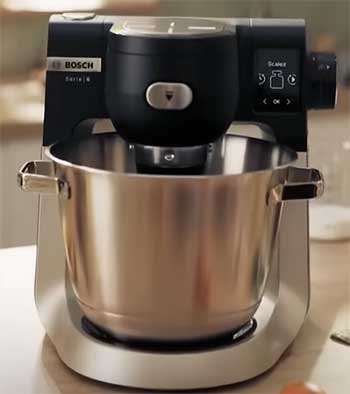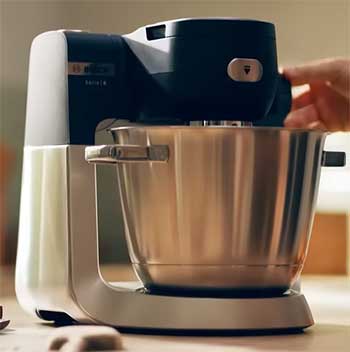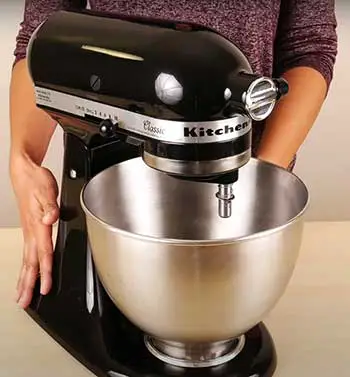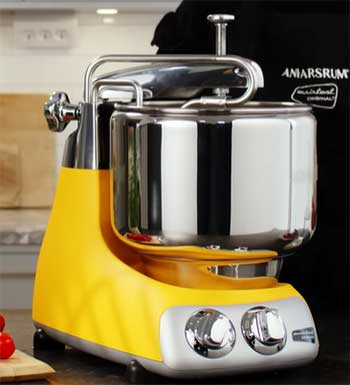If you’re tired of mixers that struggle with tough doughs or large batches, you should grab the Bosch Stand Mixer right now. I’ve used it for everything from whipping cream to kneading bread, and it transforms your kitchen routine into something effortless.
With its powerful motor and smart design, it’s a game-changer that saves time and delivers perfect results every time. Trust me, once you try it, you’ll wonder how you managed without it.
My Experience With Bosch Stand Mixer

Let me tell you about my journey with the Bosch Stand Mixer. I remember the day it arrived at my doorstep, all sleek and promising in its box.
I’d been baking for years, mostly with a hand mixer that left my arms aching after a big session, and I finally decided to upgrade.
Unboxing it felt like Christmas – the base was sturdy, with those suction cups that grip the counter like they’re never letting go.
I plugged it in, attached the dough hook, and dove right into making a double batch of pizza dough.
You know how some mixers whine and slow down when you add more flour?
Not this one. It powered through without a hitch, the planetary mixing action ensuring every bit of the bowl got covered. I was amazed at how quiet it was compared to what I expected from such a beast.
Over the next few weeks, I put it through its paces. One weekend, I hosted a family brunch and needed to whip up meringues for pavlova. The whisk attachment fluffed the egg whites into stiff peaks in minutes, something that used to take forever manually.
Then, for dinner, I shredded carrots and sliced veggies using the food processor attachment – yes, this mixer does more than just mix. It’s like having a whole kitchen arsenal in one machine. I even tried blending smoothies in the optional blender jar, and it handled frozen fruits smoothly, no chunks left behind.
But what really sold me was bread baking. I’m no professional, but I love experimenting with sourdough. The Bosch’s large bowl let me mix enough for four loaves at once, and the dough came out elastic and well-developed without overheating.
I recall one rainy afternoon when I decided to bake cinnamon rolls. I added butter, sugar, and flour, and watched as the ingredients combined seamlessly. The open-top design made it easy to scrape down the sides mid-mix, something I always struggled with in other setups.
By the end of the month, I’d used it for cakes, cookies, and even grinding meat for burgers. It felt reliable, like a trusted friend in the kitchen. Sure, it took a bit to figure out the best speeds for different tasks, but once I did, my baking game leveled up.
You get that sense of empowerment when your tools work with you, not against you. Overall, this experience turned me from a casual baker into someone who looks forward to kitchen time.
Pros of Bosch Stand Mixer

- Powerful Motor That Handles Anything You Throw at It: I can’t stress enough how the 800-watt motor makes a difference. When I’m kneading heavy dough for bagels or mixing thick batters for brownies, it doesn’t skip a beat. You add ingredients, and it keeps going strong, no overheating or stalling. This means I can tackle larger recipes without splitting them into batches, saving me precious time on busy days.
- Versatile Attachments for Multiple Kitchen Tasks: What I love is how it goes beyond mixing. With the slicer/shredder, I prep veggies for salads in seconds, and the blender handles soups or sauces effortlessly. You attach the meat grinder, and suddenly you’re making homemade sausages. It’s like upgrading your entire kitchen setup with one purchase, making it perfect for someone like me who enjoys experimenting.
- Stable and Secure Design: Those suction cups on the bottom? They’re a lifesaver. No matter how vigorously it’s mixing, the mixer stays put on my counter. I’ve had lighter machines walk around during use, but not the Bosch. This stability gives me peace of mind, especially when I’m multitasking and not hovering over it constantly.
- Large Bowl Capacity for Big Families or Batch Cooking: The 6.5-quart bowl holds up to 15 pounds of dough, which is incredible for me since I often bake for gatherings. You can mix enough cookie dough for a party or whip cream for multiple desserts without refilling. It makes entertaining easier and more fun, turning what could be a chore into a breeze.
- Quiet Operation Compared to Expectations: I was surprised at how low the noise level is. Sure, it’s not silent, but when I’m running it on high speed, I can still chat with family in the kitchen without shouting. This makes it user-friendly for everyday use, especially in smaller homes where sound carries.
- Durable Build That Lasts: From the plastic bowl to the metal drive shaft, everything feels built to endure. I’ve used mine heavily for months, and it shows no signs of wear. You invest once, and it pays off in reliability, reducing the need for frequent replacements.
- Easy to Add Ingredients Mid-Mix: The open-top design lets me pour in flour or eggs without stopping everything. It’s a small thing, but it keeps the flow going, making the whole process smoother and less messy for me.
- Efficient Mixing Action: The planetary system ensures thorough incorporation. Every corner of the bowl gets attention, so I don’t end up with unmixed pockets in my batters. You get consistent results, which boosts your confidence in the kitchen.
These advantages have made my time in the kitchen more enjoyable and productive. I find myself reaching for the Bosch more often because it handles tasks so well, encouraging me to try new recipes. If you’re like me and value power and versatility, these features will win you over quickly.
Cons of Bosch Stand Mixer
- Larger Footprint Takes Up Counter Space: It’s bulkier than some compact models, so if your kitchen is tiny, you might need to store it away between uses. I have to clear a spot each time, which can be a minor hassle.
- Higher Price Point: Compared to entry-level mixers, it’s an investment. You pay more upfront, though in my experience, the quality justifies it over time.
- Fewer Color Options: If aesthetics matter to you, the limited choices might disappoint. It’s functional first, so it doesn’t match every decor as easily.
- Attachments Sold Separately: Many extras aren’t included, so building a full set adds to the cost. I had to buy a few piecemeal.
- Slightly Louder on High Speeds: While not deafening, it can be noticeable in quiet environments. You might prefer ear protection for extended sessions.
- Bowl Material Feels Less Premium: The plastic bowl is durable but doesn’t have that hefty metal feel some people crave. It works fine, but expectations vary.
- Not Ideal for Very Small Batches: For tiny amounts, the large bowl means more scraping. I sometimes use a hand mixer for quick jobs.
These drawbacks haven’t stopped me from loving it, but they’re worth considering based on your needs.
Also Read: Comparison of Cooklee And KitchenAid Hand Mixers.
Maintenance Tips For Bosch Stand Mixer
Keeping your Bosch Stand Mixer in top shape isn’t complicated, but it does require some regular attention to ensure it lasts for years. I’ve learned through trial and error what works best, and I’ll share my approach so you can keep yours running smoothly too.
- Cleaning the Base and Exterior

Start with the outside – that’s the easiest part.
After each use, wipe down the base with a damp cloth and mild dish soap.
Avoid harsh chemicals that could damage the finish.
I make sure to dry it thoroughly to prevent any water spots or buildup.
If there’s splatter from batter, tackle it right away before it hardens.
You don’t want sticky residues attracting dust. For the control panel, use a soft cloth to gently clean around the buttons and dials, ensuring no moisture seeps in.
I’ve found that doing this immediately after mixing keeps everything looking new.
- Washing the Bowl and Attachments
The bowl, whisks, and hooks are dishwasher-safe, which is a huge plus for me. I pop them in the top rack on a gentle cycle, but sometimes I hand-wash for quicker turnaround. Use warm soapy water and a non-abrasive sponge to scrub off any residue.
For tough spots like dried dough, soak them first. Dry everything completely before storing to avoid rust on metal parts. If you have the blender attachment, rinse it under running water right after use – don’t let blends sit and harden.
- Lubricating Moving Parts
Once a year, or more if you use it heavily like I do, lubricate the gears. Unplug the mixer, remove the bowl, and access the drive area. Use a food-safe grease – I apply a small amount with a clean brush to the gears and bearings.
This prevents wear and keeps operations smooth. Wipe away any excess to avoid attracting dirt. It’s a quick task, but it makes a big difference in performance.
- Checking for Wear and Tear
Inspect regularly for any signs of damage. Look at the power cord for frays, and ensure the suction cups are intact for stability. If attachments show cracks, replace them promptly.
I also test the speeds periodically to catch any inconsistencies early. If something feels off, like unusual noises, consult the manual or a service center.
- Storage Practices
Store it in a dry, cool place. Cover the base to protect from dust. I keep attachments in a dedicated drawer, organized so they’re easy to grab. Avoid stacking heavy items on top to prevent dents.
- Handling Specific Issues
If the mixer overheats, give it a break between long sessions. For sticky dough buildup inside, use a plastic scraper. Always unplug before any deep cleaning.
By following these steps, my Bosch has stayed reliable. You invest time in maintenance, and it rewards you with consistent results. It’s all about treating it like a valued tool in your kitchen arsenal.
Also Read: Is COOKLEE Stand Mixer Worth It?
Comparison of Bosch Stand Mixer With Other Brands
When I started shopping for a stand mixer, I compared the Bosch to several others to see what fit my needs. Each brand has its strengths, but let’s break it down.
- Bosch Vs. KitchenAid

I used a KitchenAid before switching to Bosch, and the differences are clear.
The Bosch’s 800-watt motor outperforms the KitchenAid’s typical 325-575 watts, especially for dense doughs where the KitchenAid might strain.
You get more capacity effectively with Bosch – up to 15 pounds versus KitchenAid’s 10-12.
However, KitchenAid wins on style with endless colors, while Bosch focuses on function.
The tilt-head on KitchenAid makes adding ingredients simpler for some, but Bosch’s open design suits my batch cooking better. Price-wise, they’re similar, but Bosch feels more durable for heavy use.
- Bosch Vs. Ankarsrum

The Ankarsrum intrigued me with its unique roller-and-scraper system, great for artisan breads.
It handles high-hydration doughs gently, something Bosch does well too, but Ankarsrum might edge it out for very sticky mixes.
Both have large bowls, around 7 quarts, but Ankarsrum’s reverse function adds versatility.
I prefer Bosch’s planetary action for everyday baking, as it’s faster for batters.
Ankarsrum is pricier and bulkier, so if space is an issue, Bosch wins.
For serious bakers, Ankarsrum offers a premium feel, but Bosch delivers similar results at a better value.
- Bosch Vs. Breville
Breville’s Bakery Chef caught my eye with its sleek look and features like a built-in timer. It’s powerful at 550 watts, but Bosch’s 800 watts give it an edge for tougher tasks.
Breville has more speed settings for precision, which I appreciate for delicate whips, yet Bosch’s simplicity suits my straightforward style.
Both are stable, but Breville’s die-cast metal build feels more premium. If you want modern touches like LED lights, go Breville; for raw power and attachments, Bosch is my pick.
- Bosch Vs. Cuisinart
Cuisinart offers affordability with solid performance, but Bosch outshines in longevity. Cuisinart’s 500-watt motor works for basic mixing, yet struggles with large batches where Bosch excels. Attachments are comparable, but Bosch’s ecosystem feels more robust.
Cuisinart is lighter and easier to move, ideal for small kitchens, while Bosch’s heft ensures stability. For budget-conscious users, Cuisinart is tempting, but if you bake often like I do, Bosch’s reliability justifies the extra cost.
Overall, Bosch stands out for power users, but your choice depends on what you prioritize in the kitchen.
Also Read: Comparison of Hamilton Beach And KitchenAid Hand Mixers.
Frequently Asked Questions (FAQ)
It depends on your needs. If you handle heavy doughs or large quantities often, the Bosch’s stronger motor and design make it superior for those tasks. KitchenAid excels in variety and ease for lighter baking. I’ve found Bosch more efficient for my bread-making, but KitchenAid’s tilt-head is handier for quick mixes.
Absolutely, it’s excellent for versatile, heavy-duty use. The power, stability, and attachments make it a solid choice for home bakers and cooks. In my experience, it’s reliable and transforms kitchen work.
Pros include a powerful motor, large capacity, quiet operation, and versatile attachments. Cons are its size, higher cost, and fewer colors. It shines in durability but might not suit tiny kitchens.
KitchenAid often tops lists for its balance of features, colors, and accessibility. However, for specialized needs like dough, Bosch or Ankarsrum could be best. From what I’ve seen, it varies by user – KitchenAid for most, Bosch for power.
Wrapping Up
In wrapping up, the Bosch Stand Mixer has revolutionized my baking and cooking. Its reliability and power make it worth every penny.
If you’re ready to elevate your kitchen game, buy one today – you won’t regret it.
